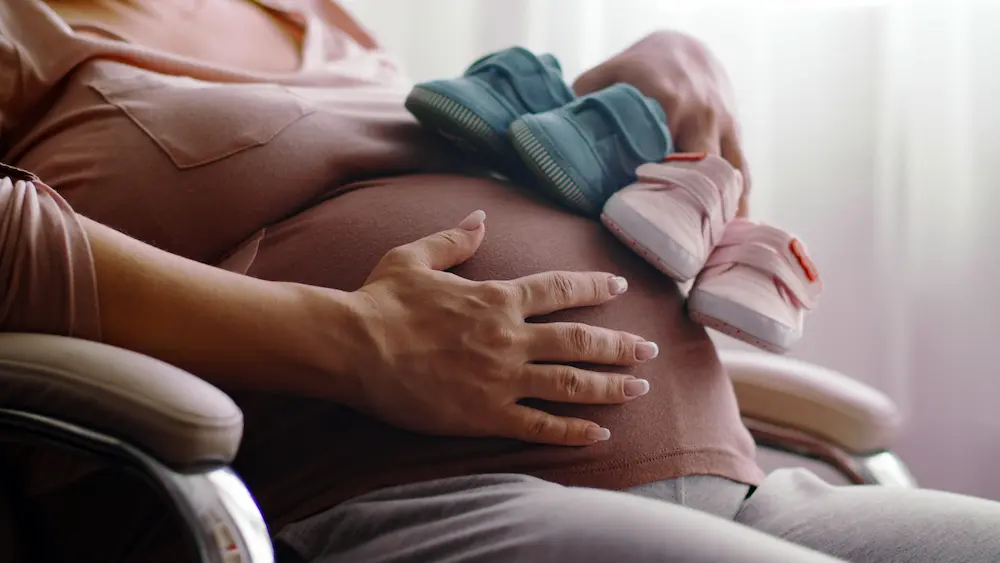
You were recently diagnosed with a twin pregnancy and you’ve just learned the sex of your babies? This article explains mixed-sex twins, meaning a girl-and-boy twin pair. What are the different types of twins? What changes for pregnancy monitoring? Girl-and-boy twins: understand it all.
Girl-and-boy twins: what are we talking about?
Mixed-sex twins, commonly called “fraternal twins,” are so-called “dizygotic” twins who are of different sexes. They are generally contrasted with monozygotic (“identical”) twins.
- Monozygotic twins: from a single fertilized egg, they share 100% of their genetic makeup and are always the same sex. They may share the same placenta and even the same sac, although this is not the most common.
- Dizygotic twins: from two different eggs fertilized by different sperm, they do not have the same genetic makeup and each has their own sac and their own placenta.
Mixed-sex twins — girl and boy — show a genetic diversity similar to siblings born from different (non-twin) pregnancies. For example, one twin may have blue eyes while the other has brown, differences in height and build, or even skin tone. Good to know: there is also a third type of twins, conjoined twins. This is a rare form of identical twins, in which the embryos do not fully separate, so they are connected by a part of the body at birth. Such births are extremely rare. 
Having mixed-sex twins: what’s the probability?
Each fetus has a 1-in-2 chance of being a boy and a 1-in-2 chance of being a girl. Thus, if you have a dizygotic pregnancy, you have a 1-in-4 chance of having 2 girls, a 1-in-4 chance of having 2 boys, and a 1-in-2 chance of having mixed-sex twins! Having mixed-sex twins, i.e., a girl and a boy, is relatively rare—just like having twins at all. Nevertheless, this is a figure that tends to increase as twin births rise. According to the National Institute for Demographic Studies (INED), twin births represented 9 deliveries per 1,000, i.e., 0.9% of births worldwide in the 1980s. This figure rose to 1.2% in the 2010s. In France, twins represent 1.5% of births today. Several factors explain these numbers.
Genetic factors
Genetic background plays a significant role in the likelihood of having dizygotic twins. Specifically, if there is a family history of twin births (particularly on the maternal side), you are more likely—or less, depending on your point of view—to be expecting twins. This is called a genetic predisposition to multiple ovulation, where more than one egg is released in a menstrual cycle.
Other factors
Several other factors can influence the probability of having twins:
- Your age: women aged 35 and over (sometimes historically labeled “geriatric pregnancies,” though that term is no longer used—people now say later-in-life pregnancies, which are increasingly common) have a higher likelihood of twin pregnancy.
- Fertility treatments: treatments such as ovarian stimulation can encourage the release of multiple eggs, increasing the chances of conceiving dizygotic twins.
- Number of previous pregnancies: women who have already had one or more pregnancies have a slightly higher probability of having twins.

The different types of twin pregnancy
Just as there are different types of twins, there are different types of twin pregnancies, whose monitoring and implications for birth may vary. Your follow-up is generally adapted based on the placenta(s) and the amniotic sac(s)—though these are not the only criteria—in order to anticipate potential complications. Here are the possible scenarios:
- Dichorionic diamniotic pregnancy: each embryo has its own placenta and its own amniotic sac. This is the lowest-risk type of twin pregnancy.
- Monochorionic diamniotic pregnancy: the embryos share the same placenta but each has their own amniotic sac.
- Monochorionic monoamniotic pregnancy: the embryos share the same placenta and the same amniotic sac, which increases the risk of complications.
These distinctions—along with your health status, history, age, and the babies’ development—influence your pregnancy monitoring as well as your care on the day of birth. Monochorionic pregnancies generally require more intensive monitoring than dichorionic ones. 
Medical monitoring of a twin pregnancy
Medical follow-up for a twin pregnancy is a bit different from that of a singleton pregnancy (one baby), since twin pregnancies carry a higher risk of complications.
Frequency of appointments
One of the main differences in follow-up concerns the frequency of appointments and ultrasounds.
- Ultrasounds: from the first trimester, monthly ultrasounds are recommended to monitor the twins’ development. This frequency may increase to twice monthly, or even weekly, if there are potential complications such as intrauterine growth restriction (IUGR) or threatened preterm labor.
- Medical appointments: at least monthly follow-up is recommended, generally within the maternity unit where the birth will take place.
Personalized care
Not all twin pregnancies require the same intensity of monitoring; therefore—as with any pregnancy—you will receive personalized care tailored to your needs to ensure your safety and that of your babies. As mentioned above, monochorionic pregnancies require special attention due to the increased risk of complications. These are often followed in level II or III maternity units, which have the resources needed to manage preterm births and handle potential complications. Good to know: in cases of high risk of preterm birth, home visits by a midwife can be arranged to perform fetal monitoring and check the condition of the cervix. Want to learn more? Feel free to download the May app, where you’ll find plenty of resources to support and guide you throughout your pregnancy. 
Expecting twins: what changes at birth?
When you’re expecting twins—whether they’re different sexes (a girl and a boy) or the same sex—the birth may require a few extra precautions.
Vaginal birth or cesarean?
Vaginal birth is generally possible with twins, especially if the first baby is head-down. However, some situations require a cesarean, notably in monochorionic monoamniotic pregnancies (where identical twins share the same placenta and the same amniotic sac) or in cases of complications such as growth restriction or a significant weight difference between the babies.
A larger medical team present
A twin birth involves a larger medical team due to the risk of complications. You can expect the presence of an obstetrician-gynecologist, midwives, nursery assistants, and sometimes a nurse. Anesthetists and pediatricians may also be present, ready to intervene quickly if needed. This ensures each baby receives the necessary attention and care from birth.
Epidural: a recommended option
Of course, the choice to have an epidural is yours. However, for twin births, note that it will often be recommended a bit more strongly than usual because it can be very helpful in case of complications (the need for an internal version of the second baby, emergency cesarean…). If the idea of an epidural worries you, don’t hesitate to discuss it with your medical team to tailor the procedure to your preferences.
Increased monitoring during labor
Although it is sometimes possible to disconnect monitoring during straightforward singleton labors without complications, this is not the case for twin births. Monitoring helps track the babies’ heart rates to respond quickly if needed. There are therefore different types of twins, including mixed-sex twins with a boy and a girl. In all cases, a twin pregnancy requires more attentive monitoring as well as greater supervision on the day of birth. Don’t hesitate to discuss these topics with your healthcare professionals to prepare as well as possible for this double motherhood. ** Photo credits: hwilson8 | StudioLucky | Alex_Studio_Ukraine | champzy
** Photo credits: hwilson8 | StudioLucky | Alex_Studio_Ukraine | champzy
This text was translated from French by an artificial intelligence. The information, advice, and sources it contains comply with French standards and may therefore not apply to your situation. Make sure to complement this reading by visiting the May US/UK app and consulting the healthcare professionals who are supporting you.




